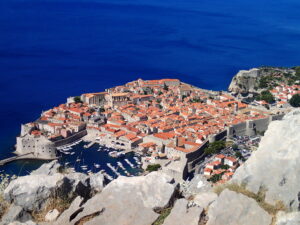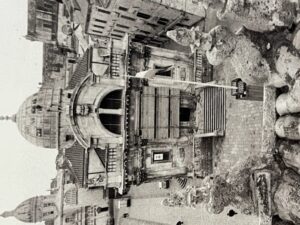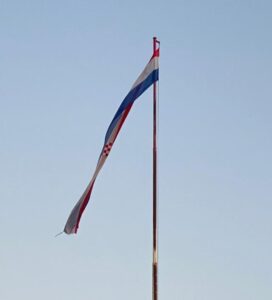Anyone who’s been to Dubrovnik will quite rightly question why I would call Mount Srd hidden Croatia. After all, it stands proudly four hundred metres above the city, a wall of rock protecting it from the outside world.
But that’s the point; we see it, but how well do we know it? The majority of visitors who actually venture up there do so by cable car, to admire the spectacular views for half an hour, perhaps drink a coffee, certainly take any number of selfies, then head straight back down again.
 To discover Mount Srd properly you need to hike, bike (neither recommended in the height of summer), take the bus, or even better book a knowledgeable driver or small group tour. Because it’s what the majority don’t see that is so very fascinating.
To discover Mount Srd properly you need to hike, bike (neither recommended in the height of summer), take the bus, or even better book a knowledgeable driver or small group tour. Because it’s what the majority don’t see that is so very fascinating.
To say we got lucky with our choice of driver is an understatement. We were staying in Cavtat along the coast so decided booking a car was the best option, and I’d ‘met’ Dubrovnik 4 U Transfers on Instagram so chose them. Kresimir is an absolute gem with a knowledge of, and a passion for, his city rarely seen in the UK. But then in the UK we haven’t had to fight for our homes.
To me that’s what Mount Srd was all about. It was certainly the focus of my visit there. I was in Croatia to add the final touches to my research for next summer’s book, where one of my main characters is a veteran of the Siege of Dubrovnik and I wanted to visit the Homeland War Museum in Fort Imperial that sits on top of the mountain.
 But there was somewhere Kresimir wanted me to see first. The village of Bosanka that had been raised to the ground by the aggressors (Serbian and Montenegrin troops) during the autumn of 1991. Of course much of it has been rebuilt, but there are some ruins left amongst the trees, and a roadside picture board in Croatian and English, making sure that visitors understand what happened here.
But there was somewhere Kresimir wanted me to see first. The village of Bosanka that had been raised to the ground by the aggressors (Serbian and Montenegrin troops) during the autumn of 1991. Of course much of it has been rebuilt, but there are some ruins left amongst the trees, and a roadside picture board in Croatian and English, making sure that visitors understand what happened here.
In fact almost the whole of Mount Srd was taken. Everything except Fort Imperial and that was to make all the difference to the survival of the city below. How it held out against all the odds on 6th December 1991 is a miracle in itself, but that is a story for a few months hence.
The fort was built by Napoleonic troops, a long, low slab of the grey-gold rock of the region, almost blending into the hillside beneath it. Even now much of it is in a semi-ruined state, but a number of rooms have been turned into a museum where visitors can learn about the Homeland War. And if you want to understand Dubrovnik and its people, you have to understand what happened here thirty years ago.
There was a sepulchral silence as we wandered through the barrel-vaulted rooms, stunned by the images of destruction displayed on their walls. The museum tells the story more or less chronologically but it is the images that hit home the hardest; iconic sights in the city below in ruins or in flames, the faces of the refugees. You don’t have to read a word of the commentary. You just have to look to understand.
 But deeper understanding comes from talking to someone who lived through the conflict and Kresimir shared his memories freely. For the first time I knew what it had been like to live in that city under siege; no power, little water, even less food. People dying around you.
But deeper understanding comes from talking to someone who lived through the conflict and Kresimir shared his memories freely. For the first time I knew what it had been like to live in that city under siege; no power, little water, even less food. People dying around you.
After our visit to the museum he took me out to the viewpoint, where there is a memorial to 6th December 1991 and a Croatian flag. I watched him take a photo of it, his pride heartfelt and genuine. To me, that said it all.
